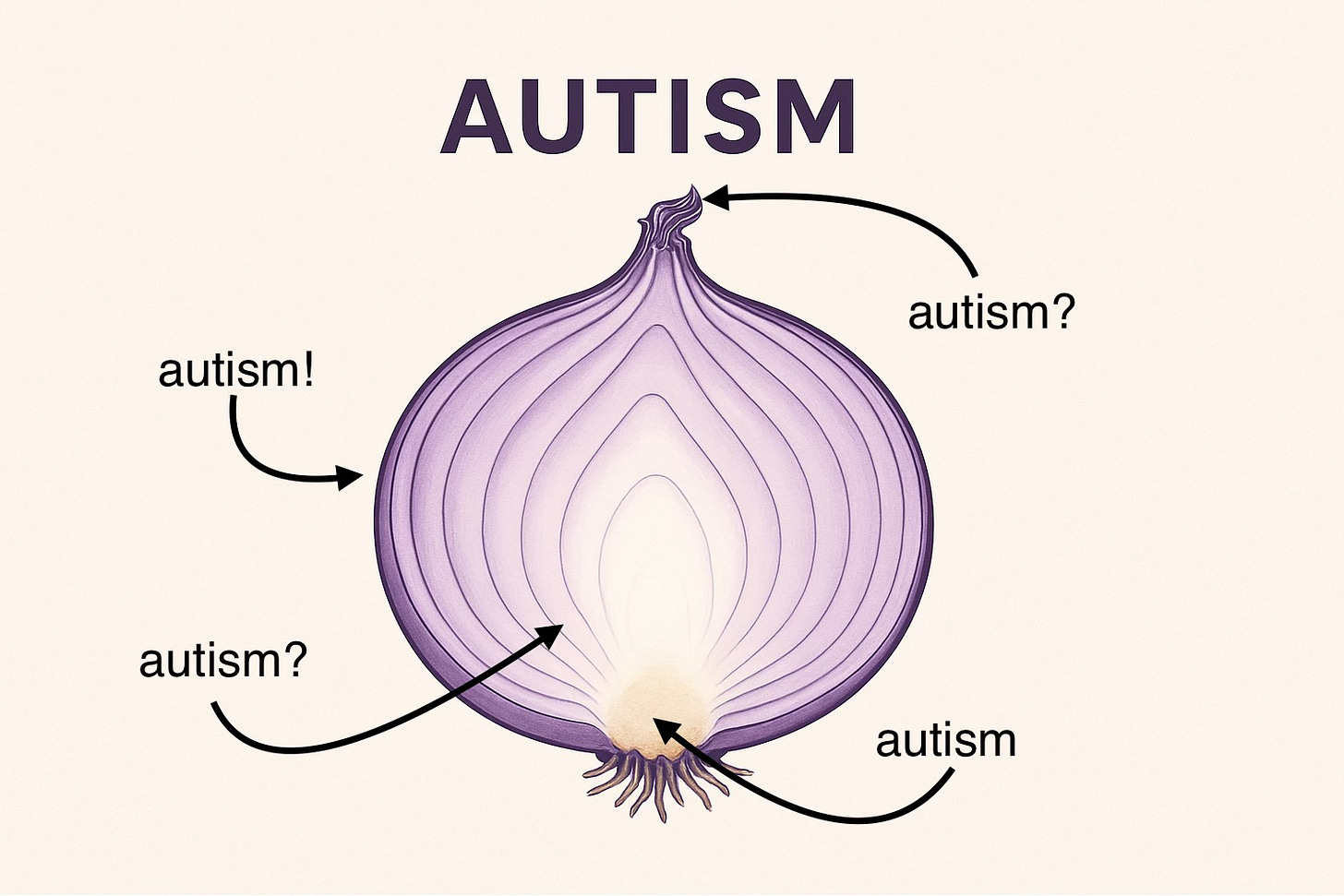Autism is Like an Onion
Peeling back the layers of perception, experience, and structure
Frames
In psychology, autism is defined from the outside in. Diagnostic manuals like the DSM-5 describe it as a set of observable behaviors: differences in social interaction and communication, patterns of restricted or repetitive interests and activities, and sensory sensitivities or differences. These criteria are shaped by what can be seen and measured in relation to the normative baseline, not by the internal architecture that produces them.
Outside of the clinical setting, the picture often narrows even further. Popular understanding is stitched together from media portrayals, selective anecdotes, and cultural shorthand—sometimes well-meaning, sometimes careless, and often incomplete. Many people imagine autism as either a visible, high-support disability or a collection of quirky traits in an otherwise “normal” person. Both frames are partial, and both miss the underlying structure entirely.
These portrayals tend to flatten autistic identity into a handful of recurring archetypes: the socially awkward genius, the silent savant, the child fixated on a single unusual topic, the adult struggling with “basic” life skills. They rarely account for the vast internal diversity of autistic cognition, or for how much of what is visible from the outside is shaped by environment, masking, and societal response.
Even when the portrayal is sympathetic, it is almost always observational. The autistic person is depicted as other—an object of fascination, pity, inspiration, or study—rather than as someone whose way of thinking is a natural and valid variation in human cognition. This persistent framing makes it difficult for most people to see autism as anything more than a collection of deficits or compensations, because that is how the concept is introduced to them in the first place.
This matters, because the way autism is defined and understood shapes everything that follows: research priorities, educational approaches, therapeutic models, public policy, and interpersonal expectations. A framework built on surface traits will always miss the structure beneath them. And without that structure, the field is left trying to describe what autism looks like without understanding what autism is.
Fractures
When autism is defined primarily through observable behavior, the picture will always be incomplete. What is being measured is the impact of autistic cognition on normative expectations—not the cognition itself. Diagnostic language is built to identify disruption to the majority standard, which means it is structurally incapable of describing autism without reference to what it is not.
This is the foundation of deficit-based psychology: a model in which divergence is recorded as a list of what fails to match the “typical” template. From this perspective, autistic traits are deviations to be explained, managed, or corrected, rather than expressions of a coherent and functional internal architecture. Even when framed as “differences” rather than “deficits,” the reference point remains the same.
The problem isn’t simply that this is insulting or limiting—it’s that it distorts the actual nature of autism. A behavior-first model cannot account for the recursive, internally consistent patterns of attention, processing, and meaning-making that give rise to those behaviors in the first place. It captures what can be seen but not what is happening. And when the inner structure isn’t recognized, the external interpretation is left vulnerable to stereotype, bias, and projection.
This framing also fails to recognize that much of what is labeled “autistic behavior” is in fact a product of interaction: how autistic people respond to environments, demands, and social pressures that do not align with their cognitive structure. Without that context, the same trait can be seen as either a problem to fix or a quirk to tolerate, depending on the observer’s values and expectations. In neither case is the autistic perspective treated as the primary source of truth.
To understand autism as it actually is, we have to start from the inside—by examining the lived autistic experience as the baseline, not the deviation.
Lives
From the inside, autism isn’t a checklist. It’s not a bundle of disconnected traits. It’s a way of thinking, perceiving, and orienting to the world that is internally coherent even when it doesn’t match external expectations.
For me—and for many autistic people—the throughline is a particular kind of cognitive continuity. Attention moves differently. It doesn’t scatter evenly across the field of what’s happening; it flows inward, locking onto points of resonance and following them deeply, often recursively. This isn’t just “special interests” in the pop-cultural sense—it’s the organizing principle of thought itself. The threads I follow determine what I notice, how I process, and how I connect information over time.
This depth-driven attention shapes everything: how sensory information lands, how social interaction is navigated, how priorities are set, how meaning is built. It can make certain kinds of focus effortless and certain kinds of multitasking exhausting. It can make detail so vivid it feels impossible to ignore, while other information—no matter how “obvious” to others—barely registers unless it ties into the active thread.
From the outside, this can be misread as rigidity, disinterest, or narrowness. From the inside, it is simply how the system runs. There’s nothing inherently deficient about it—it’s a functional architecture optimized for a different balance of depth and breadth. Where it becomes difficult is not in the structure itself, but in the constant demand to operate in environments designed for a fundamentally different attentional style.
Living autistic in a non-autistic world means navigating that mismatch daily. It means filtering every interaction through an awareness that your processing style is not the expected default—and often being asked, implicitly or explicitly, to mask it. Over time, that pressure shapes not just behavior but self-perception, embedding layers of adaptation that can obscure the underlying architecture even from ourselves.
This is why deficit-based models are so misleading: they record the friction without recognizing the fit. To see autism clearly, the architecture has to be described on its own terms. The most coherent way I’ve found to do that is through the lens of monotropism.
Shapes
Monotropism is the leading cognitive theory of autism, and for good reason. It describes exactly what deficit-based frameworks leave out: that autistic cognition is not a set of broken parts, but a system organized around a distinct attentional pattern.
In a monotropic system, attention tends to concentrate on a small number of streams at a time. These streams are not just “topics” or “hobbies,” but interconnected networks of focus that can encompass sensory processing, problem-solving, creativity, memory, and emotional meaning-making. Information isn’t passively received—it’s actively filtered, integrated, and revisited through recursive loops that deepen understanding over time.
This attentional style is efficient for depth: it allows for extraordinary persistence, pattern recognition, and conceptual coherence. But it is less optimized for breadth, for rapid switching between unrelated demands, or for holding many loosely connected threads at once. The differences that show up on the surface—whether it’s needing more time to shift tasks, or struggling with divided attention—are side effects of this core architecture, not separate “symptoms.”
My own Monotropic Expansion model builds on this theory, mapping how monotropic attention interacts with memory, sensory integration, and meaning-making to create the lived autistic experience. It examines not only how attention narrows, but how it develops inertia—momentum that resists interruption and allows for sustained recursive exploration. That inertia is not just a byproduct of focus; it is a structural feature that shapes every layer of autistic cognition.
Understanding autism through monotropism—and through the expanded view my model proposes—changes the question from what’s wrong? to how does this system work, and what is it optimized for? The answers point to a design that is highly functional in contexts that value continuity, precision, and coherence—and one that becomes vulnerable primarily when forced into environments that demand constant breadth and rapid switching.
Roots
If monotropism is the operational structure of autistic cognition, its roots are likely biological. Research suggests that autistic brains, on average, have higher synaptic density—meaning more connections between neurons—particularly in early development. This can be paired with delayed synaptic pruning, the process by which unused neural connections are trimmed back over time.
In a typical developmental trajectory, pruning streamlines the brain for faster, more generalized processing. In autistic development, reduced or delayed pruning may preserve denser, more specialized networks, allowing for richer, more recursive integration within certain domains. The trade-off is that switching between domains may require more effort, because each one is internally complex and deeply interconnected.
This architecture naturally lends itself to monotropic cognition. A dense, richly connected network can support the kind of deep, sustained attention and recursive exploration monotropism describes. Once engaged, these networks develop momentum—what I describe in my Monotropic Expansion model as cognitive inertia—making them highly resistant to being dropped mid-stream.
From an evolutionary standpoint, such a structure makes sense. A population benefits from having individuals whose attention patterns are optimized for sustained problem-solving, detail analysis, and pattern recognition. This architecture is not a defect—it’s a naturally occurring variant, one that has likely persisted because it offers complementary strengths to broader, more rapidly shifting attentional styles.
It’s also why autistic experience is so diverse. The same underlying architecture can manifest in many ways, depending on environment, co-occurring conditions, and the specific domains where that dense connectivity is most active. This is where conditions like ADHD, OCD, and synesthesia intersect in interesting ways with autism—not as separate categories with clean borders, but as different expressions shaped by variations in cognitive inertia, sensory integration, and network specialization.
Seeing autism through this lens shifts the question yet again: from what causes autistic traits? to how does this structure function across the full range of human diversity? Answering that requires not just a neurological map, but a reframing of what we even mean when we talk about “autism.”
Threads
What we currently call “autism” is not a single, cleanly bounded thing. It’s a tangle—part biological architecture, part lived cognitive reality, part social construct shaped by history, bias, and the politics of diagnosis. The definition we’ve inherited is a conflation of all of these layers, filtered through the priorities and limitations of the systems that named it.
From its beginning, autism as a diagnostic category was never a neutral scientific discovery. In the 1940s, it was formalized through two parallel but equally biased frameworks: Leo Kanner’s narrow, pathologizing view of “infantile autism” as a rare and severe disorder, and Hans Asperger’s selective framing of certain autistic children as “high-functioning” in ways that served the interests of the Nazi regime. Both approaches were shaped less by objective study of autistic cognition and more by opportunistic alignment with the values, prejudices, and institutional needs of the time.
This was also a time when psychology, as a field, was still carving out its own legitimacy—building its authority not on an understanding of cognitive architecture, but on its usefulness to existing power structures. Diagnostic categories were created and refined to identify, contain, and manage deviation from a presumed norm, not to understand divergent minds on their own terms. Autism entered the record not as a complete description of a naturally occurring neurotype, but as a container for behaviors that disrupted institutional expectations.
That origin matters because the field’s structural flaw has never been repaired. Modern psychology still builds its categories through observation of deviation, not internal function. Even when the language shifts from “disorder” to “difference,” the underlying framework remains: measuring what autism is by what it is not. The deeper deficit-based pathology entrenches itself in this model, the less capable it becomes of understanding autism at all—because the architecture it’s describing is fundamentally inaccessible through this outside-in lens.
The clinical version of autism, as it exists today, is built on observation. It measures divergence against a moving “norm” that shifts with culture and era. This means autism’s official boundaries are partly defined by what non-autistic people find notable, disruptive, or in need of explanation. As a result, the formal category captures both the structural reality of autistic cognition and a halo of traits that may be adaptive responses, environmental mismatches, or artifacts of marginalization.
The social version is even more complex. It has been shaped by decades of deficit-based framing, media stereotypes, advocacy efforts, and resistance from autistic people themselves. Public perception tends to blur together what autism is with how autistic people have been treated, how we’ve adapted, and how we’ve been forced to explain ourselves. In some ways, the very idea of “autistic identity” exists because our individual identities were flattened and erased until we had to claim the group identity to survive.
This makes autism hard to talk about with precision. The moment we speak, we are often answering three questions at once:
What is the underlying structure of autistic cognition?
What is the lived experience of being autistic in the current world?
How has that experience been shaped, for better and worse, by history and society?
Each of those is important, but they are not the same. When they’re collapsed into one, it’s easy for research to target the wrong questions, for support systems to address symptoms rather than structure, and for public conversation to circle endlessly around misunderstandings.
The consequences are visible in modern research. Studies on “reducing repetitive behaviors,” for example, are framed as if those behaviors are pathological in themselves, rather than as part of a larger system of regulation, processing, and focus. This framing is a direct descendant of the original deficit-based model—it measures difference against the norm and targets it for correction, without asking what role the behavior plays in the cognitive architecture or what harm might be done by removing it.
My current understanding is that autism, as it actually exists, is the intersection of a specific cognitive architecture—monotropic, inertia-driven, and shaped by neurological development—with a long and complicated history of misinterpretation, containment, and resistance. It is a facet of naturally occurring human diversity that has existed as long as our species has, one whose expression is broad and whose boundaries are blurry, but whose structural core is real and coherent.
Architecture
Understanding autism in its full context means holding a lot at once: the neurological architecture, the lived experience, the social history, the bias in its original categorization, and the ways those layers still overlap and distort each other today. It’s complicated not because autism itself is incoherent, but because our picture of it has been drawn with the wrong tools, on top of the wrong map, for the wrong purposes.
That complexity makes it hard to talk about. In conversation, we are often expected to compress it into a sentence, a label, or a list of traits. In advocacy, we are asked to prove both that autism is real and that it is not a deficit—two demands that would not be made of us if we were not a marginalized group. And in research and policy, we are too often treated as subjects to be studied and managed rather than as experts in the very thing being defined.
For me, mapping autism isn’t an abstract exercise. It’s a personal necessity—both because I live it and because I can’t not try to understand it. It is the same monotropic drive that shapes my focus in every other part of life, applied here to the structure of the thing itself. This is my current snapshot of that mapping: the clearest picture I can form right now of what autism is, what it isn’t, where it comes from, and how it has been shaped—not just by biology, but by history, bias, and the lived realities of autistic people pushing back against misrepresentation.
Autism is not a flaw to be corrected or an eccentricity to be indulged. It is a naturally occurring cognitive architecture that has existed for as long as our species has, one whose value cannot be measured in its resemblance to a narrow norm. Seeing it clearly—structurally, historically, and humanly—isn’t just about improving the lives of autistic people. It’s about expanding our understanding of human diversity itself, and recognizing that the health of a society depends on the inclusion, not the erasure, of the ways minds can work. ∞











Very eloquently put, Michael. I think this is a fine piece of writing that will be shared with my loved ones who are struggling to understand my recent discovery of being autistic. Thank you for putting into words what I've been wanting to express.